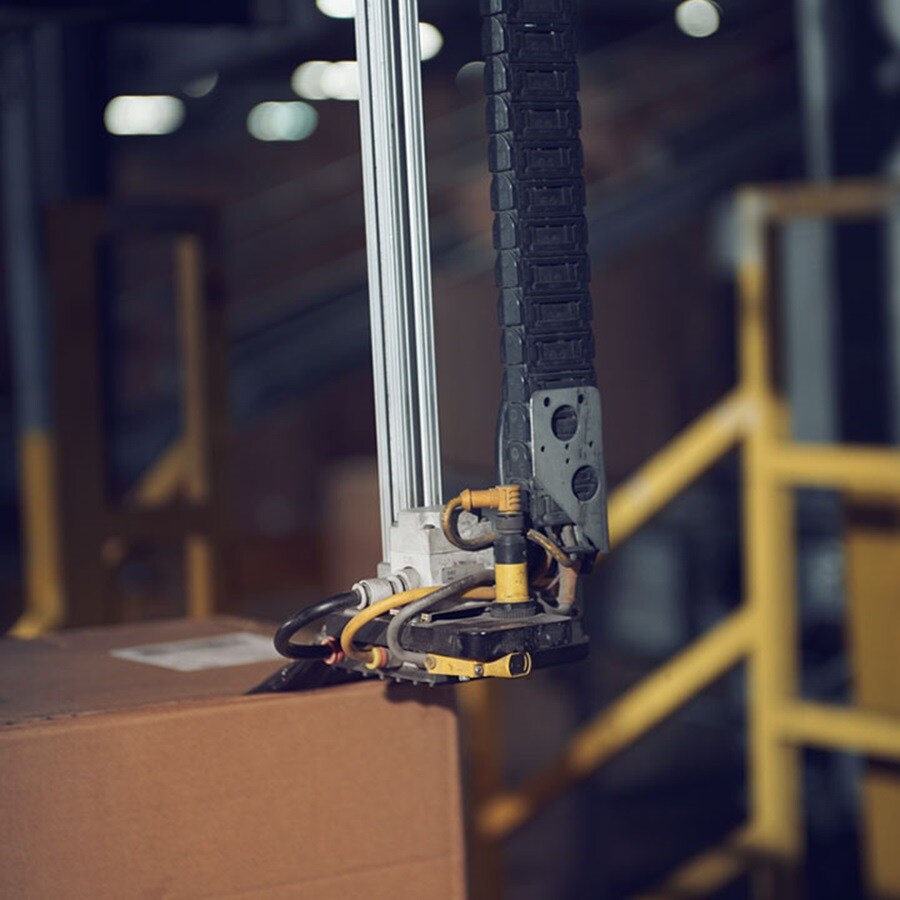The content in this article is to speak to trends and insights Maersk sees in the industry and not necessarily representing our position or strategy around automation and AI in the warehousing space across any particular region of the world.
From robotics to artificial intelligence (AI) and inventory management software – automated warehousing is ever evolving, bringing new benefits and opportunities in logistics management.
The goal of warehouse automation is to streamline and optimise operations. It involves using machines and software to automate repetitive, process-oriented, error-prone, and time-consuming tasks. Its growth in recent years has been significant. Business Wire calculates it is growing by an average of almost 15% a year to reach over USD 41 billion in 2027. The need for this, and other aspects of digitalisation in logistics, has been fuelled by ecommerce. This has led to greater shipment volumes and greater complexity in logistics. Online purchases need to be individually picked, packed, and shipped quickly.
Currently, 80% of warehouses have little or no automation in place, 15% are mechanised, and 5% are fully automated, according to ResearchandMarkets. This is in part because the cost of automating a warehouse is high. Sophisticated automation, for example, costs USD 50 million on average. Implementation times are also long - about 9 to 12 months, depending on the project. Despite this, the McKinsey Global Institute argues the transportation and warehousing industry has the third-highest automation potential of any sector. Currently, the United States, China, and Germany are the biggest players in warehouse automation. More than half of the world's automated warehouses are located there, according to Logistics HQ. The fastest growth in the warehouse sector is currently happening in the Asia-Pacific region, especially in South Asia and South-East Asia.
Digitalisation in logistics – how to streamline warehouse operations
Warehouse automation is not a new concept. It started with the introduction of steel conveyor belts in the early 1900s, progressing to the first automated storage and retrieval systems in the 1960s. Digitalisation in warehouse logistics has come a long way since. Today’s warehouse technology includes:
- Warehouse management system monitoring all stages of operations and offering better visibility
- Inventory management software to track inventory levels, sales, and orders
- Machine learning and AI to develop models to predict stock needs and plan inventory, or to help optimise warehouse layout and the use of floorspace
- Internet of Things (IoT) connecting smart devices and sensors into a network to collect and analyse data
- Computer vision to help count stock and flag low inventory, and to help locate products in a warehouse
- Blockchain as a digital transaction ledger to record and share data at every stage of the supply chain to improve accuracy and transparency
- Robots which can take over 4D tasks (dangerous, dull, dirty, or dear) or cobots (collaborative robots) which support workers by picking, lifting, packing, and transporting inventory
The rise of automation and implementation of these technologies has significantly changed warehouse operations and will continue to do so. The Materials Handling Institute expects the use of robotics in warehouses will increase 50% or more in the next five years. A recent ARC Advisory Group survey found that 33% of warehousing operations were planning to invest in conveyors and automatic sorting systems. An additional 49% had plans to use shuttle systems by 2023, which are autonomous mobile robots (AMR) and autonomous guide vehicles (AGV) used in place of forklifts to handle pallets.

Benefits from transforming warehouse operations with automation
There are many benefits associated with automated warehousing, including:
- Opportunities to improve efficiency, optimise resource use, and increase output volume
Software can help analyse data and design to maximise the performance of the warehouse. Digitalisation and technology can streamline operations and equip warehouses to handle higher density. - Improved traceability and reliability
Warehouse automation can make it easier to monitor and track goods in warehouses. This also improves consistency. - Improved accuracy and reduced human error and inventory loss
As part of automation, repetitive, labour-intensive duties can be eliminated, as can manual data entry and analysis. Increasing warehouse automation can minimise human error due to factors like fatigue and negligence. It can also improve the accuracy of inventory counts, data collection, and order fulfilment.
- Better customer experience and faster delivery to the end-customer
According to Statista, 41% of customers expect to receive their online purchase within 24 hours. Warehouse automation can help speed up the order process and get orders to end-customers faster. - Increased productivity and warehouse safety
An automated warehouse can expect to see increases in productivity of between 25% and 70%, according to Roland Berger. It can also address safety hazards and reduce or remove repetitive tasks with an injury risk. - Potential for reduced operational, labour, handling, and storage cost
With improved efficiency, accuracy, and productivity, various costs associated with warehousing can be reduced. Roland Berger says the reduction could be between 20% and 40%.
The increased efficiency, visibility, and reliability offered by warehouse automation can deliver significant value to the businesses using them. For example, the fashion brand Desigual used a technology-enabled warehouse and distribution centre in Hong Kong to streamline their ecommerce fulfilment and distribution model. The centre has automated guided vehicles (AGVs), scanners, warehouse control systems, and automated parcel handling equipment to optimise picking and packing. SupplyChain247 reports this has helped the company achieve shorter lead times and streamline its inventory management.
The future for digitalisation in logistics
The demands on warehousing and distribution have evolved quickly. This is in part due to the evolution of ecommerce where growth has gone from 28% in 2020 to 34% in 2021, according to the International Trade Administration. The Business Research Company predicts the ecommerce market to go from USD 3 billion in 2022 to over USD 4.7 billion in 2026. This will continue to drive the need for more accurate, productive, and efficient warehouses that are equipped to manage inventory and quickly fulfil orders.
Another key trend that will amplify the interest in automated warehousing are labour challenges. Already, 73% of warehouse operators can’t find enough workers, according to a Logistics Management study. The situation is likely to deteriorate in coming years, given the expectation that by 2030 there will be 85 million unfilled jobs globally (Korn Ferry).
Automation won’t solve all logistics problems, but it will create opportunities to refine and optimise warehouse operations.
Sign up to The Logistics Pulse newsletter
You did it, welcome onboard!
We're sorry, but there was a problem sending your contact request.
Please review the form fields and ensure all required information is provided correctly. If the issue persists, please contact our support team for further assistance.
Sign up to The Logistics Pulse newsletter
Receive our insights directly in your mailbox by signing up through this form and enter a world of truly integrated logistics. Get inspired by our selection of articles that help you navigate supply chains, understand industry trends, and shape your logistics strategy. You can unsubscribe anytime.













